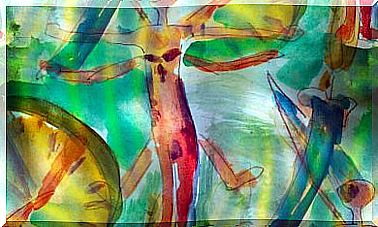Lateral Thinking: Things Are Simpler Than They Seem

We are so used to thinking in a certain way that approaching what happens to us in another way is complex and almost impossible for us. The point is that our way of thinking is often more of an obstacle than a way to make things easier. With the intention that this does not become a custom, we want to introduce you to a new way of solving problems and challenges: lateral thinking or “lateral thinking”.
The term “lateral thinking” was created by psychologist Edward de Bono to present an alternative way of thinking that consists in escaping the logical and linear way of reasoning that we normally use, in order to seek creative and original solutions to any problem or situation.
In this article, we’re going to reflect on lateral thinking, the logic of mindsets, and we’re going to propose a series of puzzles that you should get right. Do you accept the challenge?
Linear thinking as a routine
We are used to logical thinking, used to thinking linearly and solving problems sequentially, taking small steps until we find the answer. Since childhood we are taught that life is composed of complex puzzles that we must solve using our full potential in a world full of labyrinths.
Of course, life is not easy and the paths of our mind are, most of the time, a puzzle, which we must learn to decipher or, sometimes, stop trying. We are beings accustomed to seeking an explanation for everything around us.

In fact, when we’re faced with a situation about which we don’t have enough information, we fill in the missing data ourselves based on how we understand the world and on the basis of the learning we’ve built through our experiences.
The truth is that this linear way of thinking can sometimes get us into trouble because we are not able to see any further. Nobody told us that there are more paths than the one that is in a straight line. Nobody said that we can move everywhere and that if we do that we will be stimulating our minds.
The awakening of lateral thinking
As we see, logic tells us that from one step we go to the next, completing steps and advancing towards the solution. However, in lateral thinking we have to abandon the logical thinking process to solve puzzles that are simpler than they seem.
With this new kind of thinking, instead of thinking in stages, we should think, as the name implies, laterally. Not all solutions are as difficult as we think. That is, we think a lot about what exists and little about what could exist. Let’s dare to try it!
the rules of the game
Next, I propose a game to encourage your intelligence and creativity in problem solving and to put lateral thinking into practice. You just need to read the instructions and get to work:
- Read the riddle carefully.
- Choose which one you like best.
- Do not look for information about its solution.
- If you already knew the solution, try to solve another one, but don’t tell the solution right away. Help others get to it.
- Have fun, comment and participate in our social networks.

the man in the elevator
“A man lives on the tenth floor of a building. Every day he takes the elevator downstairs to work or shop. When he returns, he always takes the elevator to the seventh floor and takes the stairs the remaining three floors to reach his apartment on the tenth. Why does he do this?”
Mystery in the field
“A man died in the field. Beside you is an unopened package. There are no other beings in the field. How did he die?”
A tip: The man knew he was going to die as he approached the place.
Egypt
“Anthony and Cleopatra are found dead on the ground in a city in Egypt. Very close to them, there are broken glass. The only witness is the guard dog. There are no marks on their bodies and they have not been poisoned. How did they die?”
the island of blue eyes
“On an island there are 100 inhabitants. They all have blue or brown eyes. Everyone sees the color of others’ eyes, but not their own eyes. They cannot talk about the topic and there are no mirrors. A law states that if anyone discovers they have blue eyes, they must leave the island at 8 am the next morning. All inhabitants of the island have the same reasoning ability and all are capable of applying impeccable logic.
One day, a person arrives to visit the island, when he looks at all the inhabitants, he says, without pointing to anyone in particular: ‘How nice to be able to see at least one person with blue eyes after so long at sea!’. What consequences did this comment have on the island’s inhabitants?”.

the path of the monk
“A monk leaves his monastery at dawn towards the top of a mountain, where he arrives after walking for several hours. He stays there to rest and sleep and leaves the next morning from the top of the mountain at the same time to return to the monastery.
It is possible that he did not take the same time to get there and back, as it is likely that his speed was not constant, not counting when and how many times he stopped to rest: the monk passed by some point on the path in exactly the same hour, but one day apart. Why?”.
Solutions
the man in the elevator
The man is a dwarf. Not being able to press the button for the tenth floor on the elevator, he chooses to press the seventh and then continues down the stairs. There is no problem to go down because the button for the ground floor is at the bottom of the panel.
Egypt
Antonio and Cleopatra are colorful fish that used to live in an aquarium, which was broken by the dog.
the island of blue eyes
All people with blue eyes left the island.
If there was only one person with blue eyes, she would know that the remaining 99% would have brown eyes, so she would leave.
If there were two people with blue eyes (A) and (B), the first might think that the speaker was referring to the second and that there is only one person with blue eyes, the second would think the same thing as the first. When the first one sees that the second one didn’t leave the island on the first day, he would deduce that he also has blue eyes, so both would have to leave the second day.
The same would happen if there were three people (A), (B) and (C) with blue eyes. The first one would see that the other two had not left the island and that, therefore, he too had blue eyes, so the three would have to leave on the third day; after the first one saw that the other two didn’t leave on the second day.
And so on until all the blue-eyed inhabitants left, no matter how many they were.
the path of the monk
To answer this riddle, imagine that we have two monks who leave at the same time from the two opposite points. If you follow the same path, at some point you will necessarily meet… Now it’s clearer, isn’t it?
Everything is much easier than we think, the point is not to let ourselves fall into the traps of our thoughts and start to create new perspectives… For that, lateral thinking can help us. Dare to think differently!









